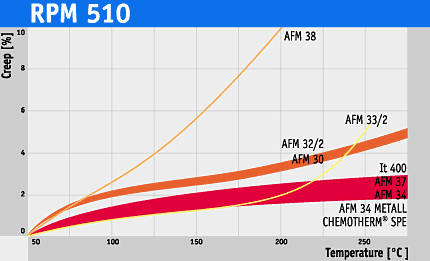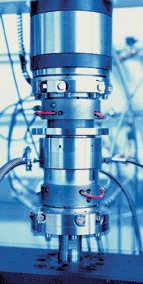|
|
|
|
|
RPM – REINZ test methods for increased safety |
|
Practice-oriented test
methods
Due to the absence of
application-oriented tests, Victor Reinz developed its own practice-oriented
test methods to give you increased safety when using asbestos-free materials.
|
RPM – Your advantage
The Reinz "RPM" test methods make it possible to obtain precise results in
terms of max. operating temperature, permissible surface pressure, internal
pressure loading, as well as compressibility and conformability of asbestos-free
materials. The selected RPM test method depends on the application, and has the
following advantages:
- Increased safety when selecting the correct gasket material
- Cost-intensive fault analysis is reduced to a minimum
- Quick change to asbestos-free materials
RPM 510 – Determining thermal resistance |
 |
Hot creep during service according to RPM 510 (surface pressure 30 N/mm2,
thickness 1.0 mm)
RPM 510 is used to determine thermal resistance (hot creep during service) as a
function of temperature, surface pressure, time, surface
roughness, and gasket geometry.
|
Hot creep during service of AFM 34 (thickness 1.0 mm) according to RPM 510-3D
RPM 505 – Determining gas sealability from the helium leakage rate
|
Helium sealability according to RPM 505
The RPM 505 test method measures gas sealability (using helium) as a
function of surface pressure, internal pressure, surface roughness, and gasket
geometry. The method is also suitable for testing gas sealability with reduced
surface pressures.
RPM 511 – Determining compressibility
|
Compressibility according to RPM 511
RPM 511 is used to test compressibility as a function of surface pressure.
Determination of helium leakage rate
|
 |
|
Preferably, pressure-dependent leakage rates are determined by means of
differential pressure (internal pressure – external pressure = 1 bar). With composite gaskets, higher
internal pressures will cause increased gas leakage,
which is roughly proportional to the internal pressure. Consequently, the leakage
rate at a higher internal pressure can be deducted from any sealing pressure
with adequate accuracy. For example, with an internal pressure of 10 bar, gas
leakage is 10 times higher. With higher internal pressures, specific measurement
are made.
|
Material factors: For example, the conversion factor from helium leakage rates to nitrogen leakage rates greatly depends on the material. For fiber materials, an approximate
factor of 3 may be assumed, i.e. 1 ml N2 is roughly equal to 3 ml He.
Temperature dependency: With calandered,
elastomer-bonded materials, temperatures up to 200 °C lead to material compression. This results in decreasing gas leakage by orders of
magnitude. On the other hand, material disintegration at higher temperatures
will cause an increase in gas leakage.
|
|
|
|
|